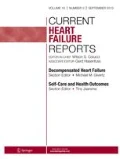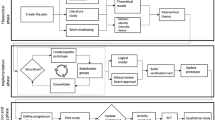Abstract
Purpose of review
The purpose of this study was to explore the potential of wearable activity trackers to promote self-care management for physical activity in heart failure (HF).
Recent findings
Exercise participation decreases hospital admissions and improves quality of life in HF, and activity tracking devices provide more precise means to assess free-living physical activity and thus enable tailored exercise instruction. Use of activity trackers by cardiac patients for self-monitoring and motivational purposes is associated with increased levels of physical activity and is predictive of disease severity. However, more research is required to establish the feasibility and validity of these devices in HF patients. It is also critical that the devices can be easily used to collect, process and utilise relevant data.
Summary
Activity trackers have the potential to promote HF self-care because they provide monitoring of physical activity behaviours and the potential to generate habit formation and goal reinforcement, all of which foster physical activity.
Similar content being viewed by others
References
Papers of particular interest, published recently, have been highlighted as: • Of importance •• Of major importance
Roger VL. Epidemiology of heart failure. Circ Res. 2013;113(6):646–59.
Curtis LH, Whellan DJ, Hammill BG, et al. Incidence and prevalence of heart failure in elderly persons, 1994–2003. Arch Intern Med. 2008;168(4):418–24.
McMurray JJ, Adamopoulos S, Anker SD, et al. ESC Guidelines for the diagnosis and treatment of acute and chronic heart failure 2012. Eur J Heart Fail. 2012;14(8):803–69.
Gheorghiade M, Zannad F, Sopko G, et al. Acute heart failure syndromes current state and framework for future research. Circulation. 2005;112(25):3958–68.
Stewart S, MacIntyre K, Hole DJ, Capewell S, McMurray JJ. More ‘malignant’than cancer? Five‐year survival following a first admission for heart failure. Eur J Heart Fail. 2001;3(3):315–22.
Stamp KD. Women with heart failure: Do they require a special approach for improving adherence to self-care? Curr Heart Fail Rep. 2014;11(3):307–13.
O’Gara PT, Kushner FG, Ascheim DD, et al. 2013 ACCF/AHA guideline for the management of ST-elevation myocardial infarction: A report of the American College of Cardiology Foundation/American Heart Association Task Force on Practice Guidelines. J Am Coll Cardiol. 2013;61(4):78–140.
Clark AM, King-Shier KM, Spaling MA, et al. Factors influencing participation in cardiac rehabilitation programmes after referral and initial attendance: Qualitative systematic review and meta-synthesis. Clin Rehabil. 2013;27(10):948–59.
Zwisler A-D, Norton RJ, Dean SG, et al. Home-based cardiac rehabilitation for people with heart failure: A systematic review and meta-analysis. Int J Cardiol. 2016;221:963–9.
Höllriegel R, Winzer EB, Linke A, et al. Long-term exercise training in patients with advanced chronic heart failure: Sustained benefits on left ventricular performance and exercise capacity. J Cardiopulm Rehabil Prev. 2016;36(2):117–24.
Smolis-Bąk E, Dąbrowski R, Piotrowicz E, et al. Hospital-based and telemonitoring guided home-based training programs: Effects on exercise tolerance and quality of life in patients with heart failure (NYHA class III) and cardiac resynchronization therapy. A randomized, prospective observation. Int J Cardiol. 2015;199:442–7.
Butte NF, Ekelund U, Westerterp KR. Assessing physical activity using wearable monitors: Measures of physical activity. Med Sci Sports Exerc. 2012;44(1):5–12.
•• Alharbi M, Bauman A, Neubeck L, Gallagher R. Validation of Fitbit-Flex as a measure of free-living physical activity in a community-based phase III cardiac rehabilitation population. Eur J Prev Cardiol. 2016;23(14):1476–85. This study validated Fitbit-Flex as a measure of free-living physical activity in a cardiac rehabilitation population.
• Ferguson T, Rowlands AV, Olds T, Maher C. The validity of consumer-level, activity monitors in healthy adults worn in free-living conditions: A cross-sectional study. Int J Behav Nutr Phys Act. 2015;12(1):42–50. This study validated seven consumer-level activity monitors (Fitbit One, Fitbit Zip, Jawbone UP, Misfit Shine, Nike Fuelband, Striiv Smart Pedometer and Withings Pulse) as measures of free-living physical activity in a healthy adult.
• Chiauzzi E, Rodarte C, DasMahapatra P. Patient-centered activity monitoring in the self-management of chronic health conditions. BMC Med. 2015;13(1):77–82. This article reviewed the feasibility of activity monitoring devices in the self-management of chronic health conditions.
Pitta F, Troosters T, Probst VS, Langer D, Decramer M, Gosselink R. Are patients with COPD more active after pulmonary rehabilitation? Chest J. 2008;134(2):273–80.
Van Remoortel H, Raste Y, Louvaris Z, et al. Validity of six activity monitors in chronic obstructive pulmonary disease: A comparison with indirect calorimetry. PLoS One. 2012;7(6):391–8.
• Fulk GD, Combs SA, Danks KA, Nirider CD, Raja B, Reisman DS. Accuracy of 2 activity monitors in detecting steps in people with stroke and traumatic brain injury. Phys Ther. 2014;94(2):222–9. This study validated two activity monitors (Fitbit Ultra and Nike Fuelband) as measures of physical activity in patients with stroke and traumatic brain injury.
Vaes AW, Cheung A, Atakhorrami M, et al. Effect of ‘activity monitor-based’counseling on physical activity and health-related outcomes in patients with chronic diseases: A systematic review and meta-analysis. Ann Med. 2013;45(5–6):397–412.
Bade B, Nietert SB. Development and implementation of an exercise prescription protocol for lung cancer patients using internet-connected fitness trackers. 2015. http://scholarexchange.furman.edu/scjas/2015/all/38/. Accessed 10 October, 2016.
Baker G, Mutrie N. Are pedometers useful motivational tools for increasing walking in sedentary adults. Paper presented at: Walk21-VI, 6th international conference on walking in the 21st century, Zurich, Switzerland. 2005.
Baker G, Gray SR, Wright A, et al. The effect of a pedometer-based community walking intervention “Walking for Wellbeing in the West” on physical activity levels and health outcomes: A 12-week randomized controlled trial. Int J Behav Nutr Phys Act. 2008;5(1):44–58.
Cupples M, Dean A, Tully M, Taggart M, McCorkell G. Using pedometer step-count goals to promote physical activity in cardiac rehabilitation: A feasibility study of a controlled trial. Int J Phys Med Rehabil. 2013;1(07):157–62.
Butler L, Furber S, Phongsavan P, Mark A, Bauman A. Effects of a pedometer‐based intervention on physical activity levels after cardiac rehabilitation: A randomized controlled trial. J Cardiopulm Rehabil Prev. 2009;29(2):105–14.
Cook DJ, Thompson JE, Prinsen SK, Dearani JA, Deschamps C. Functional recovery in the elderly after major surgery: Assessment of mobility recovery using wireless technology. Ann Cardiothorac Surg. 2013;96(3):1057–61.
Ayabe M, Brubaker PH, Mori Y, et al. Self‐monitoring moderate‐vigorous physical activity versus steps/day is more effective in chronic disease exercise programs. J Cardiopulm Rehabil Prev. 2010;30(2):111–5.
Kaminsky LA, Jones J, Riggin K, Strath SJ. A pedometer-based physical activity intervention for patients entering a maintenance cardiac rehabilitation program: A pilot study. Cardiovasc Diagn Ther. 2013;3(2):73–9.
Izawa KP, Watanabe S, Omiya K, et al. Effect of the self-monitoring approach on exercise maintenance during cardiac rehabilitation: A randomized, controlled trial. Am J Phys Med Rehabil. 2005;84(5):313–21.
Pinto BM, Goldstein MG, Papandonatos GD, et al. Maintenance of exercise after phase II cardiac rehabilitation: A randomized controlled trial. Am J Prev Med. 2011;41(3):274–83.
Furber S, Butler L, Phongsavan P, Mark A, Bauman A. Randomised controlled trial of a pedometer-based telephone intervention to increase physical activity among cardiac patients not attending cardiac rehabilitation. Patient Educ Couns. 2010;80(2):212–8.
Evangelista LS, Dracup K, Erickson V, McCarthy WJ, Hamilton MA, Fonarow GC. Validity of pedometers for measuring exercise adherence in heart failure patients. J Card Fail. 2005;11(5):366–71.
Walsh JT, Charlesworth A, Andrews R, Hawkins M, Cowley AJ. Relation of daily activity levels in patients with chronic heart failure to long-term prognosis. Am J Cardiol. 1997;79(10):1364–9.
Jehn M, Schmidt-Trucksass A, Hanssen H, Schuster T, Halle M, Koehler F. Association of physical activity and prognostic parameters in elderly patients with heart failure. J Aging Phys Act. 2011;19(1):1–15.
Schneider PL, Crouter SE, Bassett DR. Pedometer measures of free-living physical activity: Comparison of 13 models. Med Sci Sports Exerc. 2004;36(2):331–5.
Patel S, Park H, Bonato P, Chan L, Rodgers M. A review of wearable sensors and systems with application in rehabilitation. J Neuroeng Rehabil. 2012;9(1):21–37.
Heil DP, Brage S, Rothney MP. Modeling physical activity outcomes from wearable monitors. Med Sci Sports Exerc. 2012;44(1 Suppl 1):50–60.
Author information
Authors and Affiliations
Corresponding author
Ethics declarations
Conflict of Interest
Muaddi Alharbi, Nicola Straiton and Robyn Gallagher declare that they have no conflict of interest.
Human and Animal Rights and Informed Consent
This article does not contain any studies with human or animal subjects performed by any of the authors.
Additional information
This article is part of the Topical Collection on Self-Care and Health Outcomes
Rights and permissions
About this article
Cite this article
Alharbi, M., Straiton, N. & Gallagher, R. Harnessing the Potential of Wearable Activity Trackers for Heart Failure Self-Care. Curr Heart Fail Rep 14, 23–29 (2017). https://doi.org/10.1007/s11897-017-0318-z
Published:
Issue Date:
DOI: https://doi.org/10.1007/s11897-017-0318-z




